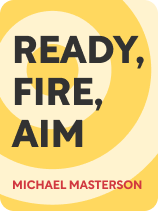

This article is an excerpt from the Shortform book guide to "Ready, Fire, Aim" by Michael Masterson. Shortform has the world's best summaries and analyses of books you should be reading.
Like this article? Sign up for a free trial here.
What’s the easiest way to figure out how to reach customers? Why should you experiment with multiple versions of your product?
In Ready, Fire, Aim, Michael Masterson argues that you shouldn’t try to perfect your product before putting it on the market. Rather, you should go ahead and put variations of it out there. Then, let that experience help you perfect your marketing strategy.
Continue reading to learn how to launch a business in Masterson’s unorthodox way.
How to Launch a Business
During the first stage of business development, your priority is to successfully launch a single product or service into the market. During this stage, you put multiple versions of your offer on the market, all the while using trial and error to test and refine what it is and how you present it. In other words, rather than focusing your resources on perfecting your product or service before you launch it, you’ll focus your resources on testing and optimizing your marketing strategy. Masterson explains that de-prioritizing the perfection of your product or service and prioritizing its marketing improves your chances of long-term success in four ways. It enables you to:
- Lower your overhead costs by helping you test your assumptions about how profitable your product or service will be before you invest significant time and resources in its development.
- Create a more valuable product or service by helping you collect feedback on how to make it more appealing to potential customers.
- Improve customer engagement by helping you learn about which marketing and sales strategies resonate with your target market.
- Fund the ongoing growth of your business by helping you acquire a customer base and generate sales.
(Shortform note: Eric Ries (The Lean Startup) expands on how marketing an imperfect product or service improves your chances of long-term success. He says one of the most common reasons new companies fail is that they overlook chances to learn and adapt their business strategies—instead, they go into business with a single plan and refuse to deviate from it. Like Masterson, Ries suggests that you can avoid this pitfall by putting a minimum viable product on the market and seeing how it performs. By doing so, you’ll know if it’s worth investing in, and you’ll have the chance to gain valuable insights into your target market and learn what your customers want and what they’ll pay for.)
Masterson suggests a four-step strategy to effectively market your first product or service:
- Determine how you’ll reach potential customers.
- Align your product or service with what potential customers want.
- Create marketing copy.
- Test different marketing strategies.
Let’s explore each step.
Step #1: Determine How You’ll Reach Potential Customers
The first step toward marketing your product or service is to determine how you’ll reach potential customers. Masterson suggests that the easiest way to figure this out is to research how established businesses in your industry advertise their offerings. This involves identifying the most successful businesses in your industry, finding out what products or services they advertise, and where and how often they advertise their offerings.
Example: Your business is in the toy industry. You identify the most successful toy companies and research their advertising strategies by looking at their websites, social media pages, and other marketing materials. You find that these companies use targeted online advertisements and social media influencers to promote their products to potential customers.
(Shortform note: Opinions differ on the best approach for reaching potential customers. Like Masterson, Alexander Osterwalder and Yves Pigneur (Business Model Generation) suggest that you define the customers you intend to target before you work on developing your offer. This way, instead of developing an offer and hoping you’ll find interested customers, you can design your offer around customers with specific needs and simultaneously develop your marketing and sales strategies to target them. Other experts, such as Jay Conrad Levinson (Guerrilla Marketing), suggest that you can’t know who your potential customers are—and, therefore, how you’ll reach them—until you first define the specific benefits of what you intend to offer.)
Step #2: Align Your Product or Service With What Potential Customers Want
Once you’ve determined how to reach your target market, the next step is to align your product or service with what potential customers want. Masterson states that it’s impossible to know whether your offer will be successful until you attempt to sell it. Therefore, you should prepare to create and market multiple variations of your offer before you commit resources to develop it.
He suggests the following process to come up with potential products or services:
1) Refer to the best-selling products or services from other businesses that you identified in Step #1 and pick one that resembles the offer you have in mind. For example, you pick a best-selling plush toy.
2) Consider all of the ways you can improve upon the existing best-selling product or service—for example, by integrating new features, making it easier to use, or improving its appearance.
Example: You note that the existing plush toy is made out of synthetic materials that aren’t environmentally friendly. You decide to improve upon this product by creating a line of organic plush toys made solely from eco-friendly materials—for instance, by using biodegradable stuffing for the interior and organic cotton fabric for the exterior.
(Shortform note: Though this method may help you create an original offer with its own unique value, it’s unlikely to change how customers feel about the existing product you’re drawing inspiration from. According to Al Ries and Jack Trout (The 22 Immutable Laws of Marketing), when consumers learn about a new product, they unconsciously perceive the brand that first introduced the product as synonymous with the product itself. For example, people often refer to tissues as Kleenex—because Kleenex was the first brand to offer facial tissues. This form of attachment makes it difficult for new brands to change how customers feel about established brands with existing products—even if the new brands offer superior products.)
3) Create prototypes for the most promising variations that you come up with.
(Shortform note: A popular approach for creating prototypes is to design a minimum viable product (MVP). Ries (The Lean Startup) explains that MVPs are not necessarily functional offers, but rather simplified versions that allow you to elicit feedback from potential customers. This could be in the form of an informational video or a website that generates interest in the offer, or a mockup that demonstrates how it would work. For example, the MVP for an organic plushie can be made from cheap, synthetic materials instead of expensive, organic ones—as long as it looks enough like the intended plushie to get feedback from potential customers about its concept and design.)
Step #3: Create Marketing Copy
Now that you have a few variations of your product or service, create marketing copy for each one. Masterson suggests a four-part process for creating effective marketing copy:
1) List all of the ways your business is unique, noting how your business is better than others in your industry.
2) Pick one of your potential products or services and list all of the ways it will benefit customers.
3) Choose one unique business quality and one product or service benefit from the above lists that you think will appeal most to potential customers. Create marketing copy that emphasizes exactly why customers should care about these two points.
4) Provide testimonials or endorsements to prove your claims.
Example: If your business sells plush toys, your unique quality may be that you’re the only business manufacturing toys solely from organic materials. Customers should care about this because other toys expose their children to harmful toxins. Your toys will benefit children by promoting healthy playtime and improving well-being. You back up your claim by providing three satisfied customer testimonials confirming the positive effects of your toys on their children’s health and behavior.
Step #4: Test Different Marketing Strategies
Now that you know how to create marketing copy, test different marketing strategies for each of your product or service variations. This involves experimenting with different ways to advertise each of your potential offers. For instance, you might experiment by emphasizing different benefits in your marketing copy, changing the selling price, or using different marketing channels to advertise your products and services.
According to Masterson, this testing process will reveal two important insights:
- The product or service variation that’s generating the most interest and sales—in other words, the offer you should commit your resources to develop.
- The most cost-effective way to acquire customers, generate sales, and increase your profits.
To complete this step, Masterson suggests creating at least two versions of marketing copy for each product or service variation. Next, experiment with placing your advertisements in different marketing channels (your list from Step 1). Track your costs and results for each experiment to determine your most profitable product or service variation, as well as the most lucrative method for reaching potential customers in your market.
| A Five-Step Process for Testing Marketing Strategies Like Masterson, Levinson (Guerrilla Marketing), recommends testing different marketing strategies to determine the most profitable course of action for your business—he offers a five-step process for achieving this. 1) Create a marketing calendar: Include all relevant details to help you plan and track your marketing activities, such as the timeline, budget, and costs for each marketing method. 2) Define what you want this marketing method to achieve: What specific action do you want customers to take in response to this method? For example, you email a newsletter with a discount code because you want customers to click on that link and complete a purchase. 3) Direct customers to take this specific action: Incorporate a simple instruction that tells customers exactly what you want them to do. For example, “Call this number,” or “Respond to this email.” 4) Integrate a tracking code into this instruction: This will help you identify how customers respond to this particular method. Use different URLs, toll-free numbers, or coupon codes to track each of your methods. 5) Measure your profits: First, total your marketing expenses for this method. Then, total the sales value that this particular method generated. Finally, deduct your marketing expenses total from your sales value. For example, your marketing expenses for this method were $500. This method generated $1,500 in sales, resulting in a $1,000 profit ($1,500 – $500 = $1,000). |

———End of Preview———
Like what you just read? Read the rest of the world's best book summary and analysis of Michael Masterson's "Ready, Fire, Aim" at Shortform.
Here's what you'll find in our full Ready, Fire, Aim summary:
- The four stages of development every successful business goes through
- How to structure your management team to handle business operations
- How to effectively market your first product or service






